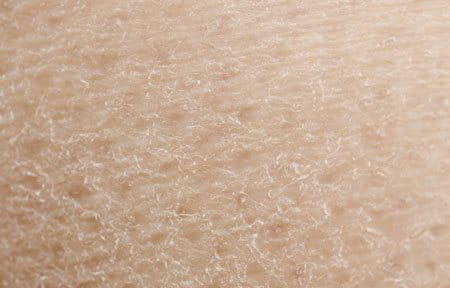There are four basic types of healthy skin: unproblematic, dry, oily and combination skin. Skin type is determined by genetics. The condition of our skin can, however, vary greatly according to the various internal and external factors it is subjected to.
Understanding the four skin types: unproblematic, dry, oily and combination
Attention
If you need help with identifying your skin type the skin test may be a useful tool. If you need further advice on how best to care for it, Eucerin recommends that you contact a dermatologist or pharmacist.

Unproblematic, well balanced skin
Unproblematic skin: Often this is referred to as “normal” skin which is a term widely used to refer to well-balanced skin (i.e. not too oily & not too dry). . The scientific term for healthy skin is eudermic.

Dry skin
‘Dry’ is used to describe a skin type that produces less sebum than normal skin. As a result of the lack of sebum, dry skin lacks the lipids that it needs to retain moisture and build a protective shield against external influences.

Oily skin
‘Oily’ is used to describe a skin type with heightened sebum production. An over production is known as seborrhea.

Combination skin
Combination skin is, as the name suggests, skin that consists of a mix of skin types.
Unproblematic Skin
What is unproblematic skin?
Unproblematic skin: Often referred to as ‘Normal skin’ is a term widely used to refer to well-balanced skin. The scientific term for healthy skin is eudermic. The T-zone (forehead, chin and nose) may be a bit oily, but overall sebum and moisture is balanced and the skin is neither too oily nor too dry.
How to identify unproblematic skin

Unproblematic skin has:
- pores that are not pronounced
- good blood circulation
- a velvety, soft and smooth texture
- no blemishes
and is not prone to sensitivity.
As a person with unproblematic skin ages, their skin can become dryer. Read more in age induced dryness.
DRY SKIN
What is dry skin?
‘Dry’ is used to describe a skin type that produces less sebum than unproblematic skin. As a result of the lack of sebum, dry skin lacks the lipids that it needs to retain moisture and build a protective shield against external influences. This leads to an impaired barrier function. Dry skin (Xerosis) exists in varying degrees of severity and in different forms that are not always clearly distinguishable.
Significantly more women suffer from dry skin than men and all skin gets dryer as it ages. Problems related to dry skin are a common complaint and account for 40% of visits to dermatologists.
The causes of dry skin


Skin moisture results from water in the deeper skin layers and from perspiration.
Skin is constantly loosing water via:
- Perspiration: active water loss from the glands caused by heat, stress and activity.
- Trans-epidermal water loss (TEWL): the natural, passive way in which skin diffuses about half a litre of water a day from the deeper skin layers.
Dry skin is caused by a lack of:
- Natural moisturising factors (NMFs) - especially urea, amino acids and lactic acid – that help to bind in water.
- Epidermal lipids such as ceramides, fatty acids and cholesterol which are needed for a healthy skin barrier function.
As a result, the skin’s barrier function can become compromised.
Find out more in dry skin.
How to identify different degrees dry skin
Dry skin ranges from skin that is a little bit drier than normal, through to very dry skin to extremely dry skin. The differences can normally be distinguished by:


Dry skin
Mildly dry skin can feel tight, brittle and rough and look dull. Skin elasticity is also low.
Very dry skin
If the dryness is not treated, skin may develop:
- mild scaling or flakiness in patches
- a rough and blotchy appearance (sometimes it appears to be prematurely aged)
- a feeling of tightness
- possible itchiness
It is also more sensitive to irritation, redness and the risk of infection. Find out more in dry skin.
Extremely dry skin
Certain areas of the body – particularly hands, feet, elbows and knees – are prone to:
- roughness
- chapping with a tendency to form rhagades (cracks)
- calluses
- scaling
- frequent itchiness
Extremely dry skin is most commonly found on the elderly or on severely dehydrated hands. Read more in rough and cracked body skin.
OILY SKIN
What is oily skin?
‘Oily’ is used to describe a skin type with heightened sebum production. An over production is known as seborrhea.
The causes of oily skin

A number of issues trigger the over production of sebum:
- genetics
- hormonal changes and imbalances
- medication
- stress
- comedogenic cosmetics (make-up products that cause irritation)
Our brand values

We deliver a holistic dermo-cosmetic approach to protect your skin, keep it healthy and radiant.

For over 100 years, we have dedicated ourselves to researching and innovating in the field of skin science. We believe in creating active ingredients and soothing formulas with high tolerability that work to help you live your life better each day.

We work together with leading dermatologist and pharmacist partners around the world to create innovative and effective skincare products they can trust and recommend.








